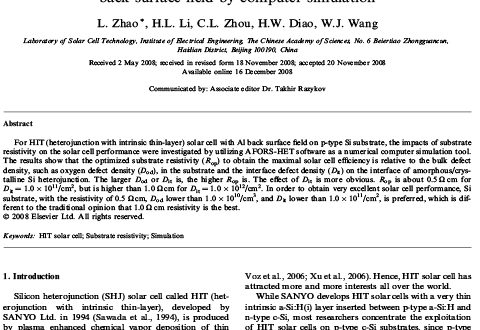Silicon heterojunction (SHJ) solar cell called HIT (heterojunction with intrinsic thin-layer). developed by SANYO Ltd. in 1994 (Sawada et al.. 1994). is produced by plasma enhanced chemical vapor deposition of thin hydrogenated amorphous silicon (a-Si:H) layers on both sides of a high quality crystalline silicon (c-Si) wafer. Such novel solar cell can simultaneously realize an excellent surface passivation and a p–n junction formation. Its low-temperature processes (<.200 C) can prevent the degradation of bulk quality that possibly happens in high-temperature cycling processes. and compared with conventional diffused cells. a much better temperature coefficient can be obtained with a higher open-circuit voltage (Voc) (Tucci et al.. 2004. Voz et al.. 2006. Xu et al.. 2006). Hence. HIT solar cell has attracted more and more interests all over the world.
While SANYO develops HIT solar cells with a very thin intrinsic a-Si:H(i) layer inserted between p-type a-Si:H and n-type c-Si. most researchers concentrate the exploitation of HIT solar cells on p-type c-Si substrates. since p-type c-Si substrates are more broadly used in current photovoltaic market (Goldbach et al.. 2006. Rostan et al.. 2006. Veschetti et al.. 2006). Si substrates with the resistivity of 1.0 X cm were thought as the best choice and were utilized generally in most works (Ok et al.. 2007. Schmidt et al.. 2007. Tardon et al.. 2004). However. as we know. it is difficult for Si wafers. even those sliced from the same ingot. to have the completely consistent resistivity. Thus. as we require Si substrates with 1.0 X cm resistivity. the vendors usually provide those wafers with the resistivity in the range of 1.0–۱۰٫۰ X cm or even 1.0–۲۵٫۰ X cm. which may be the reason why 10.0 X cm substrates were adopted in some references (Gielis et al.. 2007. Gudovskikh et al.. 2006). These seemed that 10.0 X cm resistivity was thought to be acceptable intuitively. The question is whether such a wide range of resistivity has no large impact on the performance of solar cells indeed. There is no evident data to answer this until now.
Key Words:
HIT Solar Cel. Substrate resistance. Simulation
 Iran Energy News Oil, Gas, Petrochemical and Energy Field Specialized Channel
Iran Energy News Oil, Gas, Petrochemical and Energy Field Specialized Channel




